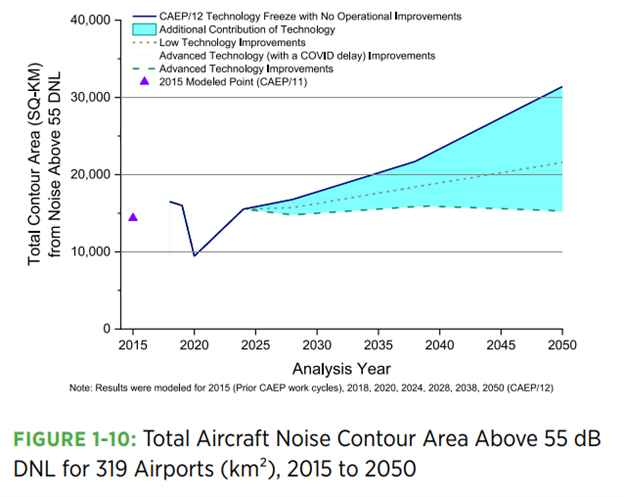Global trends in Aircraft Noise
Population counts for airports in the US, Europe, and Brazil used the latest available local census data. For all other airports, the NASA Gridded Population of the World, version 4 (GPW v4) was used.
Scenario 1 (CAEP/12 Baseline) assumes no further aircraft technology or operational improvements after 2018. Scenario 2 includes noise technology improvements of 0.1 EPNdB per annum for all aircraft entering the fleet from 2019 to 2050. Scenario 3 was meant to capture a COVID-19 delay, with no noise technology improvements for aircraft entering the fleet from 2019 to 2023, and technology improvements of 0.2 EPNdB per annum for all aircraft entering the fleet from 2024 to 2050. Scenario 4 includes noise technology improvements of 0.2 EPNdB per annum for all aircraft entering the fleet from 2019 to 2050. For Scenarios 2, 3, and 4, an additional moderate operational improvement of 2% is applied for population inside DNL 55, 60, and 65 contours.
Figure 1 shows the total 55 dB DNL noise contour area from 2010 to 2050. In 2015, this area was 14,400 square-kilometres, and the population inside that area was approximately 30 million people. By 2045, the area is expected to grow from 1.0 to 2.2 times, compared with 2015, depending on the technology scenario. Of note is that under the advanced aircraft technology scenario (Scenario 4), from about 2030 onwards, the total yearly average DNL contour area may no longer increase with an increase in traffic.
Figure 1-10 provides results for the total global 55 DNL contour area (i.e., for 319 airports) for 2018, 2019, 2020, 2024, 2028, 2038 and 2050 for the four scenarios. Historical data modelled in the prior CAEP/11 work cycle is also shown for 2015. The 2018 contour area is 16,486 square-km. This value decreases to 9,451 square-km in 2020 due to the COVID-19 downturn and increases to 15,530 square-km by 2024. In 2050 the technology freeze (Scenario 1) total global contour area is 31,407 square-km and decreases to 15,196 square-km and 21,570 square-km, with advanced and low technology improvements, respectively. The total population inside the 55 DNL contours was estimated to 37 million in 2018 and could range from 76 million under Scenario 1 to 38 million under Scenario 4 in 2050; this is under the assumption that population density around airports does not vary in time.
